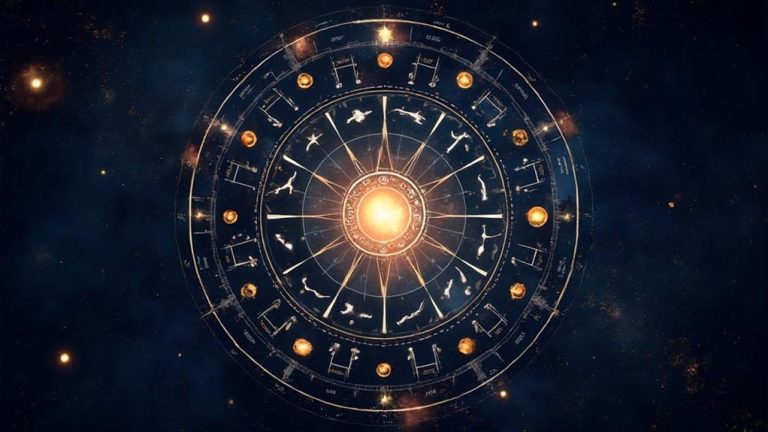Significance of Celestial Alignments in Astrology

Astrologers emphasize the importance of your birth’s exact details because they believe that the positions of celestial bodies form a unique cosmic fingerprint that shapes various aspects of your life. This is referred to as your celestial DNA, where planetary alignments influence everything from your personality to life events.
While some view astrology as speculative, its enduring relevance hints at a deeper connection between the cosmos and human experience.
Historical Origins of Celestial Alignments

Astrology has a long history, going back to civilizations like Mesopotamia, Babylon, Egypt, and Greece, where celestial alignments were mapped for both spiritual and practical purposes. Mesopotamians and Babylonians were pioneers, notably developing the zodiac, a system that divided the sky into twelve sections based on star patterns. These early interpretations of celestial alignments and astrology were deeply intertwined with agriculture, as they helped ancient societies predict seasons and plan harvests. Over time, these practices evolved, influencing not only daily life but also cultural and religious beliefs. Even today, celestial alignments and astrology continue to captivate people, blending ancient traditions with modern interpretations.
Egyptians used advanced calculations to align their pyramids with specific stars, showcasing their knowledge of astronomy for religious significance. In the Greek period (around 600 BCE), astrology advanced further as they combined Babylonian insights with geometry to develop more complex models of planetary movements. Later, cultures such as the Persians and Indians built upon these foundations, further refining the astrological system we use today.
Types of Planetary Aspects
In astrology, the term “planetary aspects” describes the angles between planets, which astrologers use to interpret how planetary energies interact. There are five major aspects:
Major Aspects Explained
- Conjunction (0°): Planets are closely aligned, amplifying their energies.
- Sextile (60°): Harmonious, creating opportunities for growth.
- Square (90°): This represents tension and challenges that prompt personal growth.
- Trine (120°): Indicates natural talents and an effortless flow between planetary energies.
- Opposition (180°): Reflects polarity, often manifesting as an internal or external push and pull.
Minor aspects like semi-sextile (30°) or quincunx (150°) are subtler and add nuance to the chart. Astrologers use “orbs” to measure how far a planet’s actual position is from its perfect aspect angle, with tighter orbs for minor aspects and wider orbs for major ones.
Major Astrological Houses

The twelve astrological houses are pivotal to a natal chart. Each house represents a specific area of life, from personal identity to career and relationships. Houses are positioned according to the individual’s birth details, and planetary placements within those houses reveal how different life themes unfold.
Houses and Their Life Themes
| House | Theme |
|---|---|
| 1st House | Identity, Appearance, and Personal Projection. |
| 2nd House | Material Resources and Personal Values. |
| 3rd House | Communication, Learning, and Local Environment. |
| 4th House | Home, Family, and Emotional Foundations. |
| 5th House | Creativity, Romance, and Pleasure. |
| 6th House | Health, Work, and Daily Routines. |
| 7th House | Relationships and Partnerships. |
| 8th House | Transformation, Shared Resources, and Sexuality. |
| 9th House | Philosophy, Higher Education, and Long Travel. |
| 10th House | Career, Ambitions, and Public Image. |
| 11th House | Friendships, Groups, and Society. |
| 12th House | Subconscious, Spirituality, and Secrets. |
Reading Your Birth Chart
A birth chart, or natal chart, is a snapshot of the sky at the moment of your birth. To read it effectively, begin by identifying key components: the Ascendant, planetary positions, and significant aspects.
Key Areas to Focus On
- Ascendant: This point reveals your outward personality and how others perceive you.
- Planets in Houses: Each planet’s house placement indicates where its energy manifests in life.
- Aspects: These show the relationships between planets and reveal the dynamic energies at play in your life.
Zodiac signs shape the planetary energy (e.g., a fiery sign like Aries boosts Mars’ assertiveness). Understanding how these signs and planets interact reveals a comprehensive picture of your character and life path.
Forecasting Through Celestial Patterns

Astrologers predict future events by studying planetary transits—how planets move in the sky compared to your natal chart. There are three primary techniques:
Key Forecasting Methods
- Transits: Compare current planetary positions to your natal chart for immediate influences.
- Progressions: Each year of your life progresses the chart, revealing long-term trends.
- Solar Returns: This happens every year on your birthday when the Sun returns to its natal position, shaping the year ahead.
Pay attention to retrogrades, eclipses, and key aspects like conjunctions, as these events tend to heighten the effects of astrological influences. Use these forecasts as a way to anticipate potential life shifts.
Frequently Asked Questions
Can Celestial Alignments Affect Human Fertility and Conception Rates?
No direct scientific evidence supports celestial alignments affecting human fertility. While some people draw links between lunar phases and menstrual cycles due to the moon’s cycles, there’s no proven connection regarding reproduction rates.
Do Planetary Alignments Influence Natural Disasters and Global Weather Patterns?
Astrologers generally don’t attribute influence over natural disasters to planetary alignments. The gravitational forces exerted by distant planets are far too weak to cause any significant impact on Earth’s climate or tectonic activity.
What Role Do Celestial Alignments Play in Determining Personality Compatibility?
Astrologers assess compatibility through synastry, where they compare the planetary positions in two birth charts. Specific angles between planets reveal potential compatibility, discord, or areas of mutual growth in a relationship.
How Do Solar Eclipses Impact Astrological Predictions Differently From Lunar Eclipses?
Solar eclipses typically predict external life changes, often related to career or major life roles. Lunar eclipses, on the other hand, focus on emotional developments and relational shifts. Both eclipse types often accelerate astrological patterns identified in a chart.
Can Celestial Alignments Predict Financial Market Trends and Economic Cycles?
While some astrologers track planetary positions like Jupiter-Saturn conjunctions to predict market trends, these alignments should be used as one tool among many. Professional financial analyses should always accompany such astrological insights.







